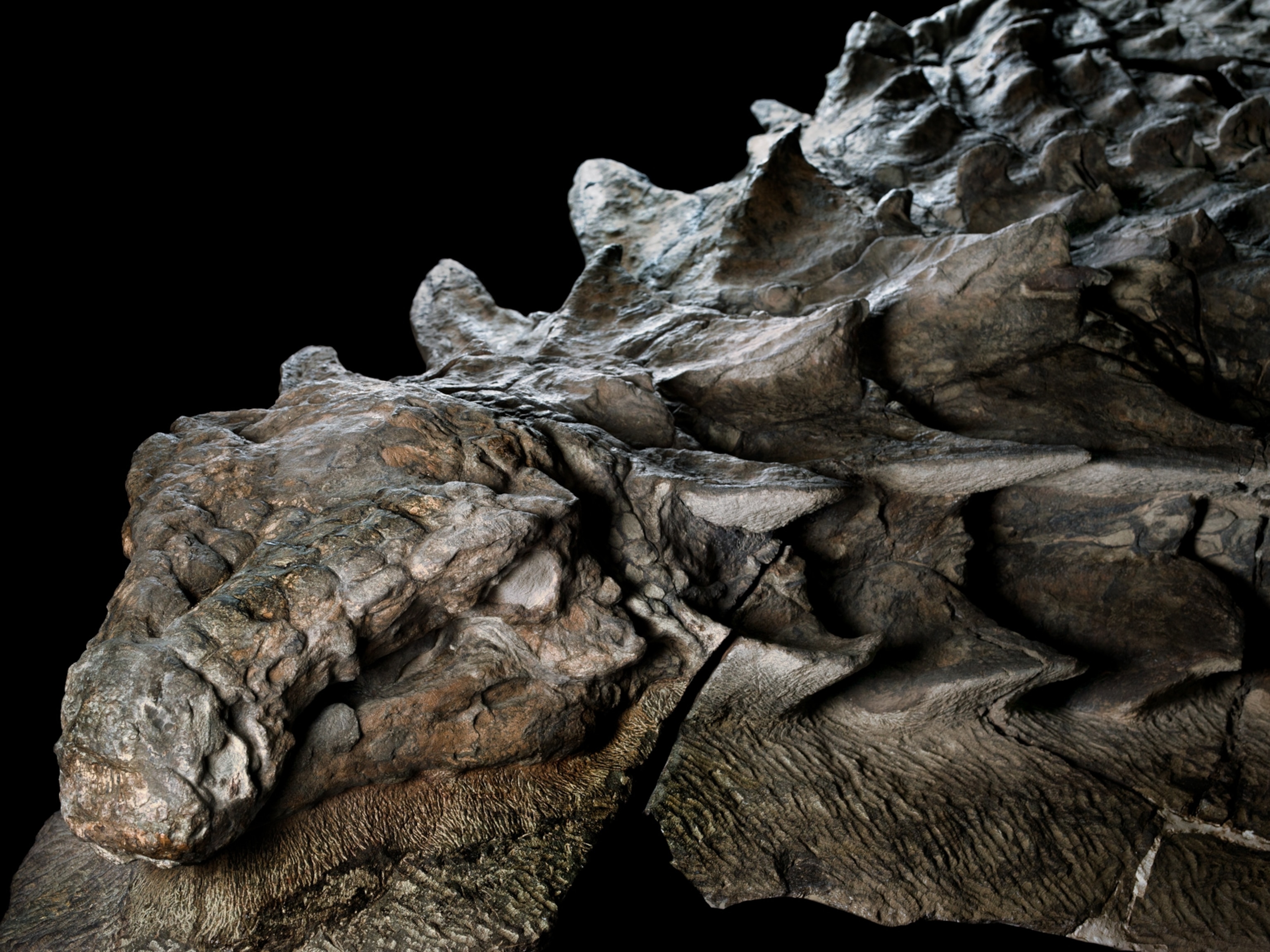This Dinosaur Is the 'Most Impressive Fossil' We've Ever Seen
Our photographer couldn't believe his eyes when he first saw the fossil—and neither will you, once you see these exclusive pictures.
It takes a lot to wow photographer Robert Clark.
Over his illustrious career, Clark has photographed more than 40 stories for National Geographic magazine, specializing in capturing the distant past of life and culture. He shot China’s exquisite feathered-dinosaur fossils. He watched researchers autopsy Ötzi the Iceman, the famous 5,000-year-old frozen mummy. And he took intimate portraits of people who lived and died 2,300 years ago—their leathery faces preserved in a bog.
But when he traveled to Alberta’s Royal Tyrrell Museum of Palaeontology last December and first laid eyes on his next photographic subject, he laughed.
Clark was staring at a 110 million-year-old fossil of a nodosaur, a type of plant-eating armored dinosaur. Its resting place undersea had helped fossilize the dinosaur’s armor, patches of its skin, some of its soft tissue—and what are likely remnants of the dinosaur’s last meal.
Discovered by an observant miner in 2011 and publicly unveiled on May 12, 2017, the fossil is the best-preserved nodosaur ever found, and arguably one of the most visually arresting fossils unearthed in decades. (Read the story of the fossil’s extraordinary journey.)
“It was like a Game of Thrones dragon,” Clark says. “It was so dimensional, like a prop from a movie.”




Shocked by the quality of its preservation, he endeavored to do the fossil justice for National Geographic’s June 2017 issue, taking pains to light the specimen in ways that highlighted its detailed features.
“This is pretty much the most impressive fossil I’ve ever seen, and I’ve seen a lot of great fossils,” says Clark. “This is kind of another level.”
Clark says that he felt a responsibility to document the fossil for perpetuity: He is likely to be one of the few photographers allowed to shoot it without the specimen under protective glass.
Beyond documenting the fossil’s scientific merit, he also recognizes how his photography can capture the public’s imagination, especially among children (some of whom, he adds, undoubtedly know more about dinosaurs than he does).
“My daughter is eight years old, and I showed some of her classmates the pictures,” he says. “They were like (explosion sound)—minds blown.”
Related Topics
You May Also Like
Go Further
Animals
- Octopuses have a lot of secrets. Can you guess 8 of them?
- Animals
- Feature
Octopuses have a lot of secrets. Can you guess 8 of them? - This biologist and her rescue dog help protect bears in the AndesThis biologist and her rescue dog help protect bears in the Andes
- An octopus invited this writer into her tank—and her secret worldAn octopus invited this writer into her tank—and her secret world
- Peace-loving bonobos are more aggressive than we thoughtPeace-loving bonobos are more aggressive than we thought
Environment
- This ancient society tried to stop El Niño—with child sacrificeThis ancient society tried to stop El Niño—with child sacrifice
- U.S. plans to clean its drinking water. What does that mean?U.S. plans to clean its drinking water. What does that mean?
- Food systems: supporting the triangle of food security, Video Story
- Paid Content
Food systems: supporting the triangle of food security - Will we ever solve the mystery of the Mima mounds?Will we ever solve the mystery of the Mima mounds?
- Are synthetic diamonds really better for the planet?Are synthetic diamonds really better for the planet?
- This year's cherry blossom peak bloom was a warning signThis year's cherry blossom peak bloom was a warning sign
History & Culture
- Strange clues in a Maya temple reveal a fiery political dramaStrange clues in a Maya temple reveal a fiery political drama
- How technology is revealing secrets in these ancient scrollsHow technology is revealing secrets in these ancient scrolls
- Pilgrimages aren’t just spiritual anymore. They’re a workout.Pilgrimages aren’t just spiritual anymore. They’re a workout.
- This ancient society tried to stop El Niño—with child sacrificeThis ancient society tried to stop El Niño—with child sacrifice
- This ancient cure was just revived in a lab. Does it work?This ancient cure was just revived in a lab. Does it work?
- See how ancient Indigenous artists left their markSee how ancient Indigenous artists left their mark
Science
- Jupiter’s volcanic moon Io has been erupting for billions of yearsJupiter’s volcanic moon Io has been erupting for billions of years
- This 80-foot-long sea monster was the killer whale of its timeThis 80-foot-long sea monster was the killer whale of its time
- Every 80 years, this star appears in the sky—and it’s almost timeEvery 80 years, this star appears in the sky—and it’s almost time
- How do you create your own ‘Blue Zone’? Here are 6 tipsHow do you create your own ‘Blue Zone’? Here are 6 tips
- Why outdoor adventure is important for women as they ageWhy outdoor adventure is important for women as they age
Travel
- This royal city lies in the shadow of Kuala LumpurThis royal city lies in the shadow of Kuala Lumpur
- This author tells the story of crypto-trading Mongolian nomadsThis author tells the story of crypto-trading Mongolian nomads
- Slow-roasted meats and fluffy dumplings in the Czech capitalSlow-roasted meats and fluffy dumplings in the Czech capital




